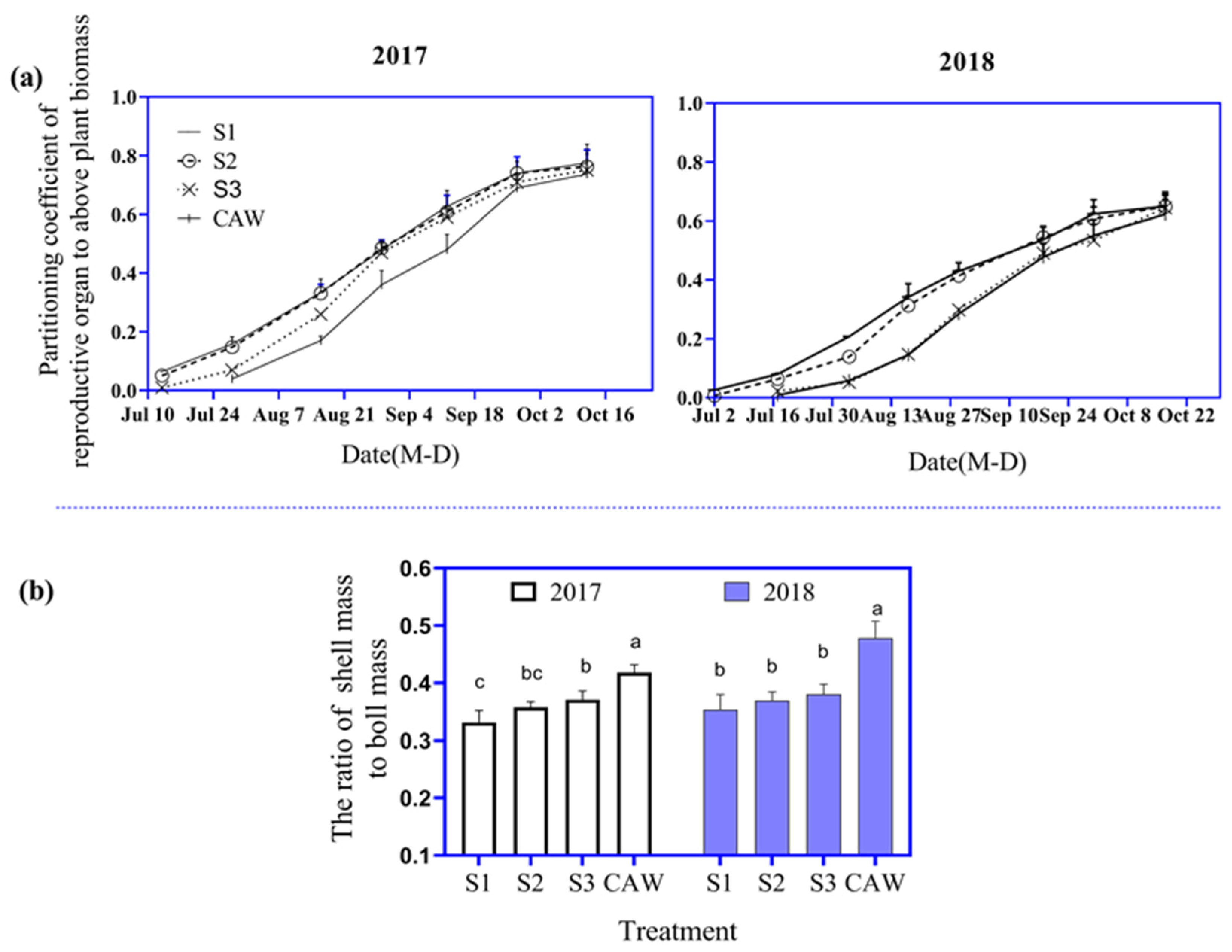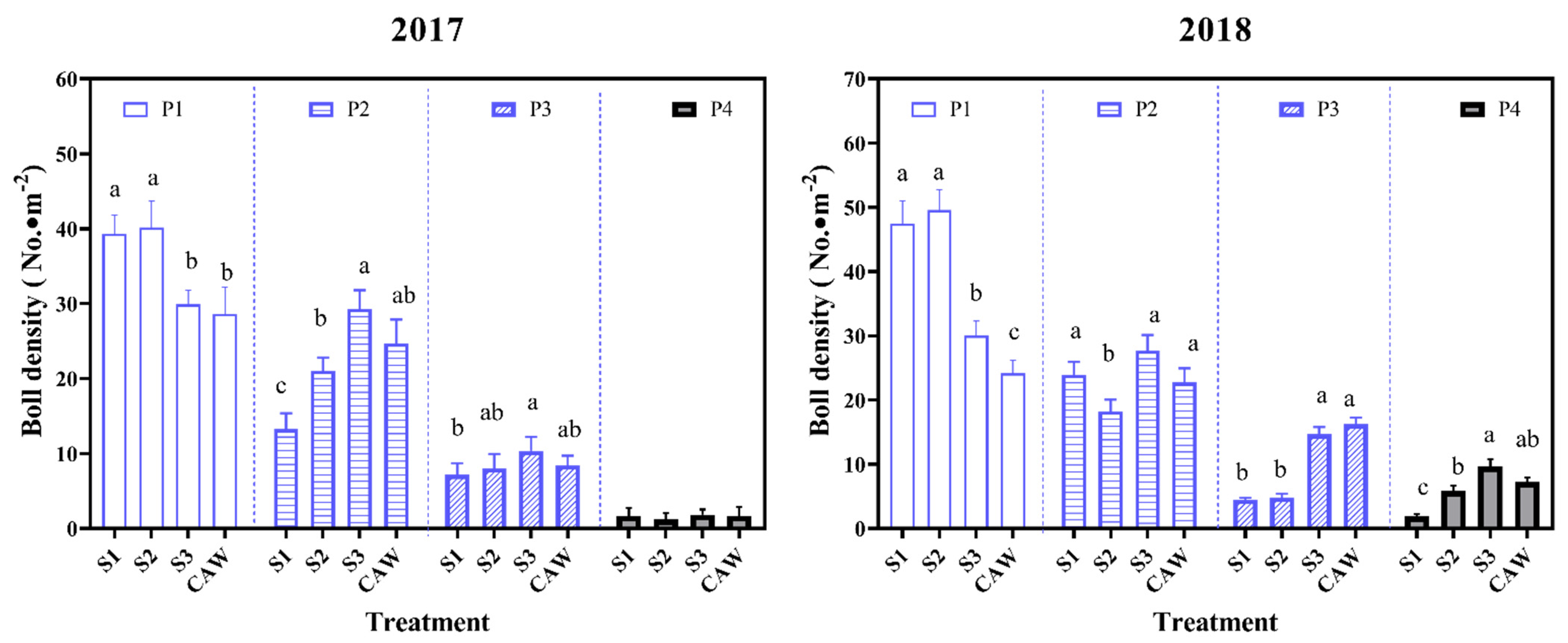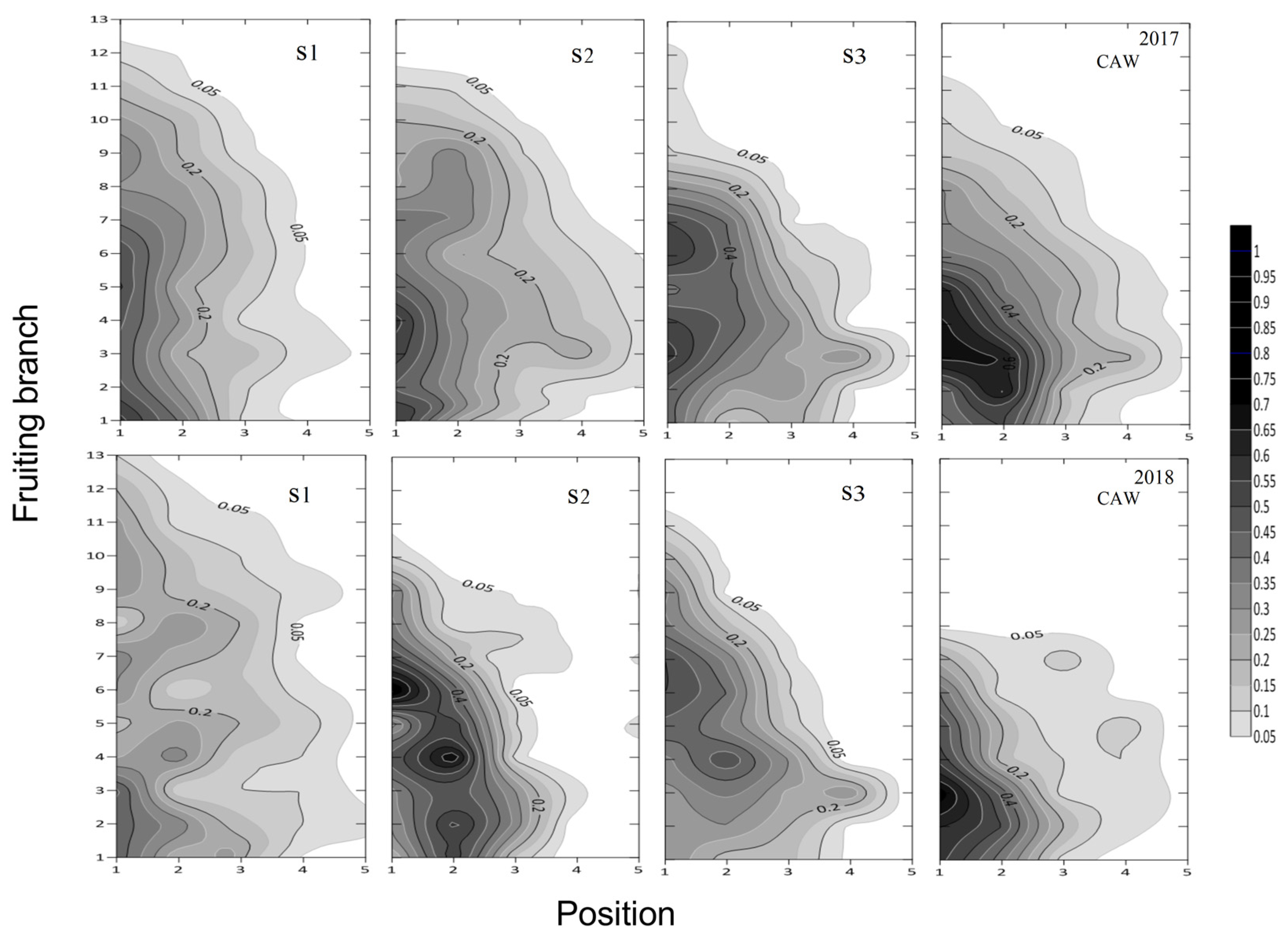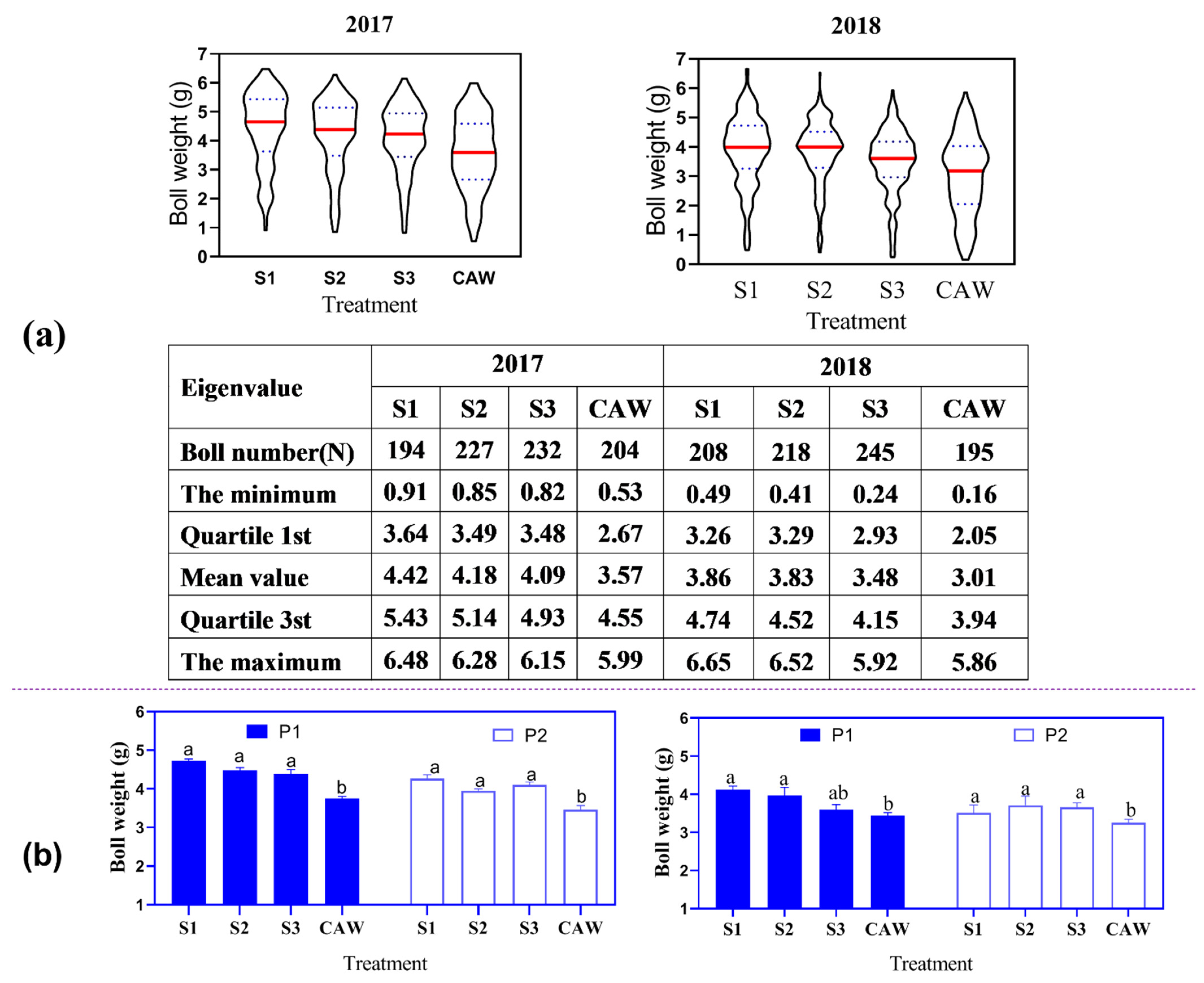Early Relay Intercropping of Short-Season Cotton Increases Lint Yield and Earliness by Improving the Yield Components and Boll Distribution under Wheat-Cotton Double Cropping
Abstract
:1. Introduction
2. Materials and Methods
2.1. Experimental Site
2.2. Experimental Design and Field Management
2.3. Data Collection
2.3.1. Agronomic Traits
2.3.2. Dry Matter Accumulation and Leaf Area
2.3.3. Plant Mapping
2.3.4. Yield and Yield Components and Land Equivalent Ratio (LER)
2.3.5. Fiber Quality
2.3.6. Data Analysis and Statistics
3. Results
3.1. Cotton Yield, Yield Components and LER
3.2. Earliness and Fiber Quality
3.3. Biomass Accumulation and Partitioning
3.3.1. Harvest Index
3.3.2. Biomass Accumulation and Partitioning
3.3.3. Dry Matter Partitioning Coefficient and the Boll Shell Proportion
3.4. Agronomic Traits
3.5. Boll Distribution
3.5.1. Temporal Distribution of Bolls
3.5.2. Spatial Distribution of Bolls
3.5.3. Boll Retention Distribution
3.5.4. Boll Weight Distribution
4. Discussion
4.1. Relay Intercropping of Short-Season Cotton Greatly Increased the Lint Yield and Fiber Quality Compared to CAW
4.2. Early Relay Intercropping Improved the Yield Components and Spatiotemporal Distribution of Bolls Compared to Late Relay Intercropping
5. Conclusions
Author Contributions
Funding
Institutional Review Board Statement
Informed Consent Statement
Data Availability Statement
Conflicts of Interest
References
- Cotton Research Institute, Chinese Academy of Agricultural Sciences (CRI, CAAS). Cultivation of Cotton in China; Shanghai Science and Technology Press: Shanghai, China, 2013; pp. 78–84, 309–321, 497–524. (In Chinese) [Google Scholar]
- Wang, G.P.; Mao, S.C.; Han, Y.; Li, Y.B.; Feng, L.; Fan, Z. The study on wheat-cotton double cropping system in China. Chin. Agric. Sci. Bull. 2012, 28, 14–18. (In Chinese) [Google Scholar]
- Feng, L.; Wang, G.; Han, Y.; Li, Y.; Zhu, Y.; Zhou, Z.; Cao, W. Effects of planting pattern on growth and yield and economic benefits of cotton in a wheat-cotton double cropping system versus monoculture cotton. Field Crops Res. 2017, 213, 100–108. [Google Scholar] [CrossRef]
- Sajjad, A.; Anjum, S.A.; Ahmad, R.; Waraich, E.A. Relay cropping of wheat (Triticum aestivum L.) in cotton (Gossypium hirsutum L.) improves the profitability of cotton-wheat cropping system in Punjab. Environ. Sci. Pollut. Res. 2018, 25, 782–789. [Google Scholar] [CrossRef]
- Jalota, S.K.; Buttar, G.S.; Sood, A.; Chahal, G.B.; Ray, S.S.; Panigrahy, S. Effects of sowing date, tillage and residue management on productivity of cotton (Gossypium hirsutum L.)—Wheat (Triticum aestivum L.) system in northwest India. Soil Tillage Res. 2008, 99, 76–83. [Google Scholar] [CrossRef]
- Das, T.; Bhattacharyya, R.; Sudhishri, S.; Sharma, A.; Saharawat, Y.; Bandyopadhyay, K.; Sepat, S.; Bana, R.; Aggarwal, P.; Sharma, R.; et al. Conservation agriculture in an irrigated cotton–wheat system of the western Indo-Gangetic Plains: Crop and water productivity and economic profitability. Field Crops Res. 2014, 158, 24–33. [Google Scholar] [CrossRef]
- Du, X.; Chen, B.; Shen, T.; Zhang, Y.; Zhou, Z. Effect of cropping system on radiation use efficiency in double-cropped wheat-cotton. Field Crops Res. 2015, 170, 21–31. [Google Scholar] [CrossRef]
- Zulfiqar, F.; Shang, J.; Nasrullah, M.; Rizwanullah, M. Allocative efficiency analysis of wheat and cotton in district Khanewal, Punjab, Pakistan. GeoJournal 2020, 86, 2777–2786. [Google Scholar] [CrossRef]
- Singh, K.; Choudhary, O.P.; Singh, H.P.; Singh, A.; Mishra, S.K. Sub-soiling improves productivity and economic returns of cotton-wheat cropping system. Soil Tillage Res. 2019, 189, 131–139. [Google Scholar] [CrossRef]
- Zhang, L.; van der Werf, W.; Zhang, S.; Li, B.; Spiertz, J.H.J. Growth, yield and quality of wheat and cotton in relay strip intercropping systems. Field Crops Res. 2007, 103, 178–188. [Google Scholar] [CrossRef]
- Zhang, L.; van der Werf, W.; Zhang, S.; Li, B.; Spiertz, J.H.J. Temperature-mediated developmental delay may limit yield of cotton in relay intercrops with wheat. Field Crops Res. 2008, 106, 258–268. [Google Scholar] [CrossRef]
- Dong, H.; Mao, S.C.; Zhang, W.F.; Chen, D.H. On Boll-Setting Optimization Theory for Cotton Cultivation and Its New Development. Sci. Agric. Sin. 2014, 47, 441–451. (In Chinese) [Google Scholar] [CrossRef]
- Qi, J.; Dai, J.; Sun, X.; Dong, H. Short-Season Cotton: Mechanism of Early Maturity and its Cultivation. Cotton Sci. 2018, 30, 406–413. (In Chinese) [Google Scholar] [CrossRef]
- Zhou, G.L.; Wang, G. A brief discussion on the current situation of harvesting mechanization of main crops in China. Agric. Mach. 2010, 03, 105–106. (In Chinese) [Google Scholar] [CrossRef]
- Zhang, X.; Rui, Q.; Li, Y.; Chen, Y.; Chen, Y.; Chen, D.; Song, M. Architecture of stem and branch affects yield formation in short season cotton. J. Integr. Agric. 2020, 19, 680–689. [Google Scholar] [CrossRef]
- Yang, C.Q.; Zhang, G.W.; Liu, R.X.; Wang, X.; Ni, W. Effects of sowing dates on lint yield, fiber quality, and use of nitrogen, phosphorus and potassium in cotton field-seeded after barley or oilseed rape harvest in Yangtze River Valley. Chin. J. Eco-Agric. 2020, 28, 42–49. (In Chinese) [Google Scholar] [CrossRef]
- Wang, G.P.; Wang, G.Y.; Liu, L.T.; Zhang, Y.; Feng, L.; Han, Y.; Li, Y.; Li, C.D. An Economic Benefit Analysis and Prospect of Wheat and Cotton Double Cropping Pattern in the Yellow River Valley. J. Hebei Agric. Univ. 2020, 22, 33–40. (In Chinese) [Google Scholar] [CrossRef]
- Zhao, W.; Meng, Y.; Chen, B. Effects of Fruiting-Branch Position, Temperature-Light Factors and Nitrogen Rates on Cotton (Gossypium hirsutum L.) Fiber Strength Formation. Sci. Agric. Sin. 2011, 44, 3721–3732. (In Chinese) [Google Scholar] [CrossRef]
- Zhi, X.; Han, Y.; Xing, F.; Lei, Y.; Wang, G.; Feng, L.; Yang, B.; Wang, Z.; Li, X.; Xiong, S.; et al. How do cotton light interception and carbohydrate partitioning respond to cropping systems including monoculture, intercropping with wheat, and direct-seeding after wheat? PLoS ONE 2019, 14, e0217243. [Google Scholar] [CrossRef]
- Khan, A.; Najeeb, U.; Wang, L.; Tan, D.K.Y.; Yang, G.; Munsif, F.; Ali, S.; Hafeez, A. Planting density and sowing date strongly influence growth and lint yield of cotton crops. Field Crops Res. 2017, 209, 129–135. [Google Scholar] [CrossRef]
- Boquet, D.J.; Clawson, E.L. Cotton Planting Date: Yield, Seedling Survival, and Plant Growth. Agron. J. 2009, 101, 1123–1130. [Google Scholar] [CrossRef]
- Hu, W.; Chen, M.-L.; Zhao, W.-Q.; Chen, B.-L.; Wang, Y.-H.; Wang, S.-S.; Meng, Y.-L.; Zhou, Z.-G. The effects of sowing date on cottonseed properties at different fruiting-branch positions. J. Integr. Agric. 2017, 16, 1322–1330. [Google Scholar] [CrossRef] [Green Version]
- Willey, R.W. Evaluation and Presentation of Intercropping Advantages. Exp. Agric. 1985, 21, 119–133. [Google Scholar] [CrossRef] [Green Version]
- Liu, J.; Meng, Y.; Chen, J.; Lv, F.; Ma, Y.; Chen, B.; Wang, Y.; Zhou, Z.; Oosterhuis, D.M. Effect of late planting and shading on cotton yield and fiber quality formation. Field Crops Res. 2015, 183, 1–13. [Google Scholar] [CrossRef]
- Pang, N.; Wei, X.; Gui, H. Cotton Plant map Application Recording System and Preliminary Statistics. China Cotton 2017, 44, 16–18. (In Chinese) [Google Scholar] [CrossRef]
- Lei, Y.; Han, Y.; Wang, G.; Feng, L.; Yang, B.; Fan, Z.; Zhi, X.; Wang, Z.; Xiong, S.; Wei, X.; et al. A Method for Digitization of Information for Cotton Plant Mapping. Cotton Sci. 2018, 30, 92–101. (In Chinese) [Google Scholar] [CrossRef]
- Dong, H.; Li, W.; Xin, C.; Tang, W.; Zhang, D. Late planting of short-season cotton in saline fields of the Yellow River delta. Crop Sci. 2010, 50, 292–300. [Google Scholar] [CrossRef]
- Wang, X.; Hou, Y.; Du, M.; Xu, D.; Lu, H.; Tian, X.; Li, Z. Effect of planting date and plant density on cotton traits as relating to mechanical harvesting in the Yellow River valley region of China. Field Crops Res. 2016, 198, 112–121. [Google Scholar] [CrossRef]
- Dong, H.; Li, W.; Tang, W.; Li, Z.; Zhang, D.; Niu, Y. Yield, quality and leaf senescence of cotton grown at varying planting dates and plant densities in the Yellow River Valley of China. Field Crops Res. 2006, 98, 106–115. [Google Scholar] [CrossRef]
- Lu, H.; Dai, J.; Li, W.; Tang, W.; Zhang, D.; Eneji, A.E.; Dong, H. Yield and economic benefits of late planted short-season cotton versus full-season cotton relayed with garlic. Field Crops Res. 2017, 200, 80–87. [Google Scholar] [CrossRef]
- Liu, J.; Ma, Y.; Lv, F.; Chen, J.; Zhou, Z.; Wang, Y.; Abudurezike, A.; Oosterhuis, D.M. Changes of sucrose metabolism in leaf subtending to cotton boll under cool temperature due to late planting. Field Crops Res. 2013, 144, 200–211. [Google Scholar] [CrossRef]
- Killi, F.; Bolek, Y. Timing of planting is crucial for cotton yield. Acta Agric. Scand. Sect. B-Plant Soil Sci. 2006, 56, 155–160. [Google Scholar] [CrossRef]
- Pettigrew, W.T.; Molin, W.T.; Stetina, S.R. Impact of Varying Planting Dates and Tillage Systems on Cotton Growth and Lint Yield Production. Agron. J. 2009, 101, 1131–1138. [Google Scholar] [CrossRef] [Green Version]
- Bednarz, C.W.; Nichols, R.L. Phenological and Morphological Components of Cotton Crop Maturity. Crops Sci. 2005, 45, 1497–1503. [Google Scholar] [CrossRef]
- Boquet, D.J.; Moser, E.B. Boll retention and boll size among intrasympodial fruiting sites in cotton. Crops Sci. 2003, 43, 195–201. [Google Scholar] [CrossRef]
- Luo, H.-H.; Wang, Q.; Zhang, J.-K.; Wang, L.-S.; Li, Y.-B.; Yang, G.-Z. One-time fertilization at first flowering improves lint yield and dry matter partitioning in late planted short-season cotton. J. Integr. Agric. 2020, 19, 509–517. [Google Scholar] [CrossRef]
- Zhao, X.; Shu, H.; Wang, Y.H. Effects of Sowing Date on Accumulation and Distribution of Biomass and Nitrogen in Cotton Bolls. Acta Agron. Sin. 2010, 36, 1707–1714. (In Chinese) [Google Scholar] [CrossRef]
- Bange, M.P.; Milroy, S.P. Growth and dry matter partitioning of diverse cotton genotypes. Field Crops Res. 2004, 87, 73–87. [Google Scholar] [CrossRef]
- Schaefer, C.; Nichols, B.; Collins, G.; Whitaker, J.; Bednarz, C.; Main, C.; Ritchie, G. Cotton Maturity Determination through Vertical Mapping. Crops Sci. 2016, 57, 62–70. [Google Scholar] [CrossRef]
- Ritchie, G.L.; Whitaker, J.R.; Bednarz, C.W.; Hook, J.E. Subsurface Drip and Overhead Irrigation: A Comparison of Plant Boll Distribution in Upland Cotton. Agron. J. 2009, 101, 1336–1344. [Google Scholar] [CrossRef]
- Li, W.; Zhou, Z.; Meng, Y.; Xu, N.; Fok, M. Modeling boll maturation period, seed growth, protein, and oil content of cotton (Gossypium hirsutum L.) in China. Field Crops Res. 2009, 112, 131–140. [Google Scholar] [CrossRef]
- Cao, T.-V.; Oumarou, P.; Gawrysiak, G.; Klassou, C.; Hau, B. Short-season cotton (Gossypium hirsutum L.) may be a suitable response to late planting in sub-Saharan regions. Field Crops Res. 2011, 120, 9–20. [Google Scholar] [CrossRef]







| Year | Soil Depth (cm) | PH | Organic Matter (g kg−1) | Total Nitrogen (g kg−1) | Available Phosphorus (mg kg−1) | Available Potassium (mg kg−1) |
|---|---|---|---|---|---|---|
| 2016 | 0–20 | 7.82 | 14.5 | 1.05 | 64.5 | 235.6 |
| 20–40 | 7.98 | 11.2 | 0.71 | 46.5 | 99.6 | |
| 2017 | 0–20 | 7.93 | 13.9 | 1.18 | 37.5 | 266.8 |
| 20–40 | 8.01 | 8.9 | 1.09 | 25.6 | 122.7 | |
| 2018 | 0–20 | 7.92 | 13.8 | 1.28 | 52.7 | 243.1 |
| 20–40 | 8.02 | 8.6 | 0.89 | 24.9 | 111.3 |
| Treatment | Lint Yield (kg/hm2) | Boll Density (Bolls/m2) | Boll Weight (g) | Lint Percentage (%) | Earliness ** (%) * | Biological Yield (kg/hm2) | Harvest Index | Wheat Yield (kg/hm2) | LER *** |
|---|---|---|---|---|---|---|---|---|---|
| 2016 | |||||||||
| S1 * | 1079a | 71.2b | 3.98a | 37.9a | 77.6a | 7800b | 0.365a | 7546a | 1.560a |
| S2 | 1028a | 70.2b | 3.90a | 37.5a | 76.0a | 7594b | 0.361a | 7742a | 1.555a |
| S3 | 1003a | 75.6a | 3.75b | 37.2a | 71.1a | 8025a | 0.336b | 7781a | 1.545a |
| CAW | 717b | 57.7b | 3.53c | 35.2b | 50.6b | 6592b | 0.309c | 7844a | 1.387b |
| 2017 | |||||||||
| S1 | 1103a | 68.9b | 4.22a | 38.0a | 84.8a | 7539b | 0.385a | 8574a | 1.575a |
| S2 | 1138a | 70.0b | 4.21a | 38.5a | 83.6a | 7738b | 0.382a | 8742a | 1.613a |
| S3 | 1095a | 72.8a | 4.02a | 37.3a | 68.0b | 8177a | 0.359b | 8786a | 1.595a |
| CAW | 700b | 57.5b | 3.57b | 34.1b | 45.9c | 6935c | 0.296c | 8821a | 1.382b |
| 2018 | |||||||||
| S1 | 1076a | 79.2b | 3.86a | 35.5a | 80.7a | 8603b | 0.355a | 7953a | 1.598a |
| S2 | 1064a | 78.5b | 3.83a | 35.3a | 78.3a | 8612b | 0.350a | 7977a | 1.594a |
| S3 | 988a | 81.9a | 3.58b | 34.7a | 58.5b | 9039a | 0.315b | 8067a | 1.560a |
| CAW | 686b | 69.5c | 3.01c | 31.8b | 37.8c | 7543c | 0.286c | 8132a | 1.390b |
| Average | |||||||||
| S1 | 1086a | 73.2ab | 4.02a | 37.5a | 81.1a | 7913b | 0.366a | 8024a | 1.578a |
| S2 | 1077a | 73.1ab | 3.98a | 37.2a | 79.3a | 7981b | 0.364a | 8154a | 1.588a |
| S3 | 1028a | 76.8a | 3.78b | 36.4b | 65.9b | 8414a | 0.337b | 8211a | 1.567a |
| CAW | 701b | 61.4b | 3.37c | 33.9c | 44.8c | 7023c | 0.297c | 8266a | 1.386b |
| Source of variance (p-value) | |||||||||
| Year (Y) | 0.1675 | 0.001 | <0.001 | <0.001 | 0.0147 | <0.001 | <0.001 | <0.001 | 0.2076 |
| Sowing date (SD) | <0.001 | 0.0361 | <0.001 | <0.001 | <0.001 | <0.001 | <0.001 | 0.4436 | <0.001 |
| Y × SD | 0.5457 | 0.5134 | 0.0125 | 0.0127 | 0.0325 | 0.6731 | <0.001 | 0.9994 | 0.7572 |
| Treatment | Fiber Length (mm) | Strength (cNtex−1) | Micronaire Value |
|---|---|---|---|
| 2016 | |||
| S1 | 29.6a | 30.1a | 4.28a |
| S2 | 29.8a | 29.8a | 4.20a |
| S3 | 29.2a | 28.1ab | 3.96b |
| CAW | 28.2a | 26.7c | 3.73c |
| 2017 | |||
| S1 | 29.4a | 30.7a | 4.35a |
| S2 | 29.6a | 30.1a | 4.11a |
| S3 | 30.0a | 29.7ab | 4.00a |
| CAW | 28.7a | 28.2b | 3.73b |
| 2018 | |||
| S1 | 30.6a | 30.5a | 4.27a |
| S2 | 29.9a | 29.4ab | 4.16a |
| S3 | 29.7a | 29.0ab | 3.61b |
| CAW | 29.5a | 27.3b | 3.19c |
| Average | |||
| S1 | 29.9a | 30.4a | 4.29a |
| S2 | 29.8a | 29.8ab | 4.16a |
| S3 | 29.6a | 29.1b | 3.85b |
| CAW | 28.8a | 27.4c | 3.55c |
| Source of variance (p-value) | |||
| Year (Y) | 0.1793 | 0.0203 | 0.0289 |
| Sowing date (SD) | 0.0971 | <0.001 | <0.001 |
| Y × SD | 0.7647 | 0.7423 | 0.2819 |
| Year | Treatment | T1 () | T2 (DAE *) | Vm (g·plant−1 d−1) | ΔT (d) | Wmax (g·plant−1) | R2 |
|---|---|---|---|---|---|---|---|
| 2016 | S1 | 91.4a | 122.8 | 12.84 | 31.4 | 612.2a | 0.9929 |
| S2 | 82.1b | 112.1 | 12.59 | 30.0 | 573.9ab | 0.9939 | |
| S3 | 78.6c | 104.0 | 14.16 | 25.3 | 544.8b | 0.9995 | |
| CAW | 78.0c | 101.7 | 15.04 | 23.6 | 539.8b | 0.9998 | |
| 2017 | S1 | 85.2a | 112.2 | 12.30 | 33.2 | 619.8a | 0.9931 |
| S2 | 78.2ab | 111.8 | 11.47 | 33.6 | 592.6a | 0.9970 | |
| S3 | 73.7c | 100.1 | 13.76 | 26.4 | 551.6b | 0.9993 | |
| CAW | 73.0c | 98.0 | 14.95 | 25.0 | 547.1b | 0.9954 | |
| 2018 | S1 | 89.0a | 123.4 | 15.10 | 34.4 | 794.1a | 0.9841 |
| S2 | 84.8b | 118.2 | 13.80 | 33.4 | 696.7b | 0.9846 | |
| S3 | 82.1b | 111.8 | 14.90 | 29.6 | 671.1b | 0.9949 | |
| CAW | 75.5c | 101.2 | 15.36 | 25.7 | 611.5c | 0.9897 |
| Treatment | Plant Height (cm) | Fruiting Branch (No.plant−1) | Fruiting Sites (No.plant−1) | Ratio of Fruiting Sites to Fruiting Branch | Maximum Leaf Area (cm2 plant−1) |
|---|---|---|---|---|---|
| 2016 | |||||
| S1 | 57.0a | 11.3a | 28.8b | 2.55a | 2898ab |
| S2 | 54.1a | 10.6ab | 30.7a | 2.90a | 3012a |
| S3 | 56.5a | 9.5b | 27.9b | 2.94a | 2835a |
| CAW | 51.2b | 8.2c | 20.9c | 2.58a | 2692b |
| 2017 | |||||
| S1 | 58.9a | 9.7a | 29.1a | 3.02b | 3200a |
| S2 | 62.4a | 9.5a | 31.7a | 3.33ab | 3263a |
| S3 | 62.6a | 9.0a | 32.0a | 3.61a | 2967b |
| CAW | 46.8b | 6.9b | 22.4b | 3.23ab | 2640c |
| 2018 | |||||
| S1 | 52.4b | 12.3a | 29.1a | 2.38b | 3527a |
| S2 | 57.7a | 11.4a | 30.5a | 2.69ab | 3367a |
| S3 | 56.2ab | 10.3b | 31.2a | 3.03a | 3039b |
| CAW | 46.7c | 8.9c | 26.7b | 3.01a | 2970b |
| Mean | |||||
| S1 | 56.1a | 11.1a | 29.0a | 2.65b | 3208a |
| S2 | 58.1a | 10.5b | 31.0a | 2.97a | 3221a |
| S3 | 58.4a | 9.6c | 30.6a | 3.19a | 2947b |
| CAW | 48.3b | 8.0d | 23.3b | 2.94ab | 2767c |
| Source of variance (p-value) | |||||
| Year (Y) | 0.0015 | <0.001 | 0.0397 | <0.001 | <0.001 |
| SD | <0.001 | <0.001 | <0.001 | 0.003 | <0.001 |
| Y × SD | 0.007 | 0.3625 | 0.1297 | 0.4441 | 0.0194 |
Publisher’s Note: MDPI stays neutral with regard to jurisdictional claims in published maps and institutional affiliations. |
© 2021 by the authors. Licensee MDPI, Basel, Switzerland. This article is an open access article distributed under the terms and conditions of the Creative Commons Attribution (CC BY) license (https://creativecommons.org/licenses/by/4.0/).
Share and Cite
Wang, G.; Feng, L.; Liu, L.; Zhang, Y.; Li, A.; Wang, Z.; Han, Y.; Li, Y.; Li, C.; Dong, H. Early Relay Intercropping of Short-Season Cotton Increases Lint Yield and Earliness by Improving the Yield Components and Boll Distribution under Wheat-Cotton Double Cropping. Agriculture 2021, 11, 1294. https://doi.org/10.3390/agriculture11121294
Wang G, Feng L, Liu L, Zhang Y, Li A, Wang Z, Han Y, Li Y, Li C, Dong H. Early Relay Intercropping of Short-Season Cotton Increases Lint Yield and Earliness by Improving the Yield Components and Boll Distribution under Wheat-Cotton Double Cropping. Agriculture. 2021; 11(12):1294. https://doi.org/10.3390/agriculture11121294
Chicago/Turabian StyleWang, Guoping, Lu Feng, Liantao Liu, Yongjiang Zhang, Anchang Li, Zhanbiao Wang, Yingchun Han, Yabing Li, Cundong Li, and Hezhong Dong. 2021. "Early Relay Intercropping of Short-Season Cotton Increases Lint Yield and Earliness by Improving the Yield Components and Boll Distribution under Wheat-Cotton Double Cropping" Agriculture 11, no. 12: 1294. https://doi.org/10.3390/agriculture11121294
APA StyleWang, G., Feng, L., Liu, L., Zhang, Y., Li, A., Wang, Z., Han, Y., Li, Y., Li, C., & Dong, H. (2021). Early Relay Intercropping of Short-Season Cotton Increases Lint Yield and Earliness by Improving the Yield Components and Boll Distribution under Wheat-Cotton Double Cropping. Agriculture, 11(12), 1294. https://doi.org/10.3390/agriculture11121294





